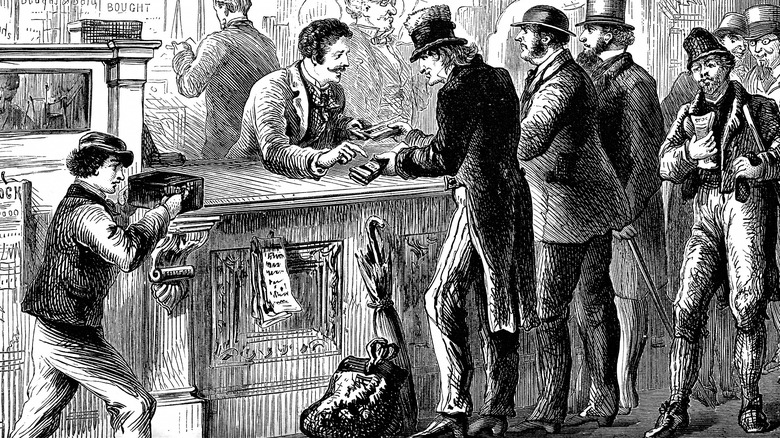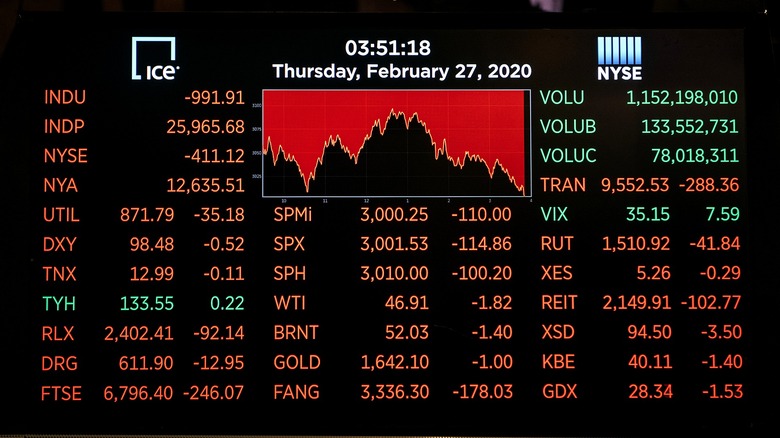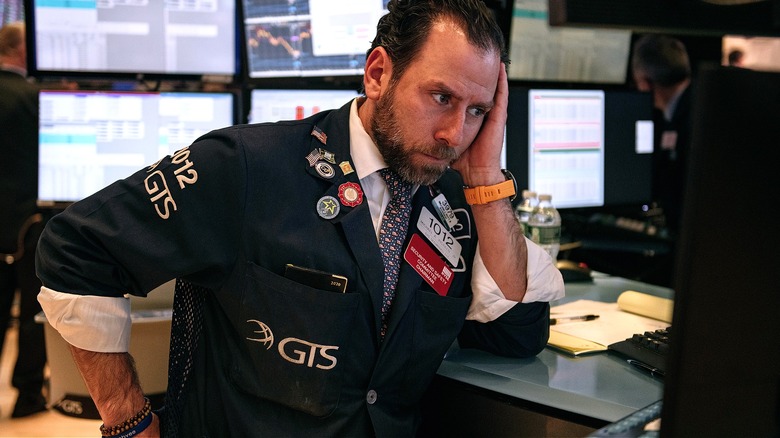What Happens When The Stock Market Crashes?
A stock market crash happens when share prices drop abruptly, dramatically, and unexpectedly — with eventual declines over 20% from a recent high. When a stock market starts to crash, it often leads to panic selling from investors, which only further exacerbates the situation. Stock market crashes historically have been in response to economic instability, political turmoil, or a major catastrophic event.
In 2020, for example, when the stock markets crashed around the world, it was in response to the anxiety and uncertainty in the early days of the COVID-19 pandemic. While there are measures in place today to calm crashing activity (that is, circuit breakers), these measures alone can't prevent a crash. And once a stock market crashes, getting out of it can take anywhere from weeks to much longer. This is also unpredictable.
The 2020 stock market crash, for example, which had three of the biggest point drops for the Dow Jones Industrial Average in United States history, had a record-fast recovery. The crash, which began on February 20, ended on April 7. By June, the stock market had rebounded and was closing in on pre-pandemic highs.
When the stock market starts to crash
Today, when equity exchanges or indexes start to see share prices drop suddenly and sharply, there are measures in place to help investors take a literal break from trading. Called circuit breakers, these temporary measures halt trading market-wide if the S&P 500 drops by 7% (Level 1), 13% (Level 2), or 20% (Level 3). They were implemented in 1987 by the U.S. Securities and Exchange Commission in response to "Black Monday," the 1987 stock market crash when the Dow lost 508 points in one day, nearly 23%, on October 19.
How long the circuit breakers last depends on the level and time of day. Per the SEC, for Levels 1 and 2, if the circuit breaker is triggered before 3.25 p.m., then trading halts for 15 minutes. If either level gets triggered after 3:25 p.m., trading continues. But, if a market declines by 20%, triggering Level 3, then trading halts for the day.
Midway through the 2020 stock market crash, Level 1 triggered three times in one week, as stock prices dropped quickly on March 9, 12, and 16. On March 16, the S&P 500 declined by 7% not long after the bell rang at the New York Stock Exchange, triggering Level 1. Yet, 15 minutes couldn't stop the trend, with March 16 earning the nickname of "Black Monday II." Trading ended with the largest percentage loss ever for the Nasdaq at 12.3%; the second-largest for the Dow, 12.9%; and the third-biggest for the S&P 500 at 12%.
What to do if the stock market crashes
Stock market crashes and market corrections are oftentimes confused for one another, as in both cases, share prices are falling. However, a stock market crash, which again is abrupt, is categorized when prices drop beyond 20% from a previous high, while market corrections are gradual and stay above 10% but below 20%. The 2020 stock market crash declined 30% in 22 days from a previous peak on February 19. When the crash ended on April 7, traders saw the S&P 500 drop 34% at its lowest point (on March 23), while the Dow declined 37%.
But as noted, the stock market bounced back quickly from the crash, only to face a bear market in 2022, with experts needing to reach back to 2008 and the Great Recession to find a comparable year. In 2022, the S&P 500 declined nearly 20% while the Dow was down 9% to close out the year; the Nasdaq, with all its tech stocks, lost 33%. These declines were brought on by rising inflation, rates, and inevitable panic selloffs.
So what to do when the market starts to crash or correct? An alternative to panic selling is to not change how you invest no matter what's happening. Dollar-cost averaging is an investment strategy designed for the long haul, where you invest a fixed amount in a stock on a regular basis; basically, it's like autopay. With this approach, you never react to what's happening to the market, no matter how volatile it may be.


